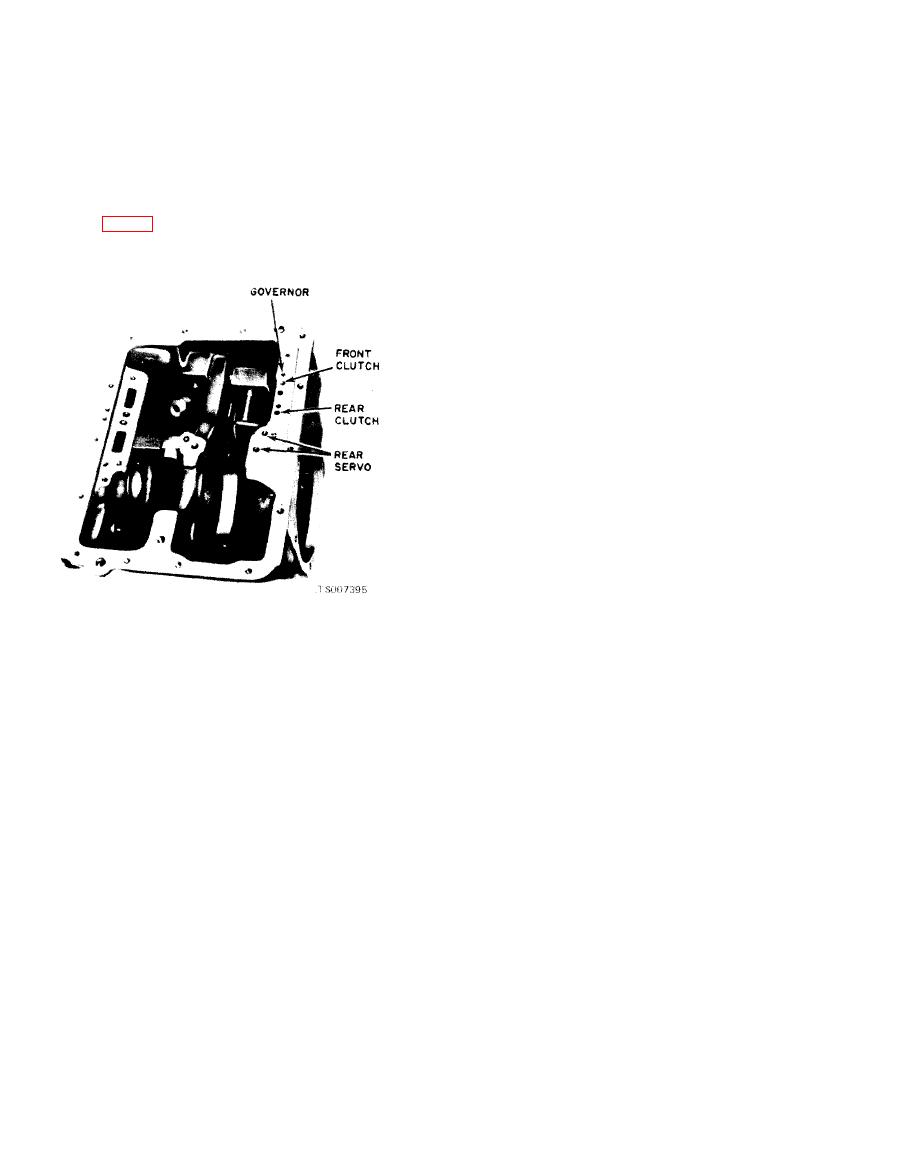 |
|||
|
|
|||
|
Page Title:
Figure 7-6. Air Pressure Checks. |
|
||
| ||||||||||
|
|
 TM 10-3930-633-34
b. Test Set-up. To make the air pressure
clutch or operates both clutches at once, remove
checks, loosen the oil pan bolts and lower one
and, with air pressure, check the fluid passages in
edge of the oil pan to drain the transmission fluid.
the case and front pump to detect obstructions.
Remove the pan and the control valve body
assembly. The inoperative units can be located by
a. Check the governor inspection plate on the
introducing air pressure into the transmission
extension housing for leakage. Replace gasket if
case passages leading to the clutches, servos, and
leakage is apparent.
governor (fig. 7-6). 50-75 PSI pressure is suf-
b. Leakage at the oil pan gasket often can be
ficient for purposes of this test.
stopped by tightening the attaching bolts to the
proper torque. If necessary, replace the gasket.
c. Check the fluid filler tube connection at the
transmission case or pan. If leakage is found here,
install a new O-ring or tighten the fitting to the
specified torque.
d. Check the fluid lines and fittings between
the transmission and the cooler in the radiator
tank for looseness, wear, or damage. If leakage
cannot be stopped by tightening a fitting, replace
the damaged parts.
e. Check the engine coolant in the radiator. If
transmission fluid is present in the coolant, the
cooler in the radiator is probably leaking.
f. The cooler can be further checked for leaks
by disconnecting the lines from the cooler fittings
and applying 50-75 PSI air pressure to the fit-
tings. Remove the radiator cap to relieve the
pressure build-up at the exterior of the oil cooler
tank. If the cooler is leaking and will not hold
pressure, the radiator must be replaced. See TM
10-3930-633-12.
c. Front Clutch. Apply air pressure to the
g. If leakage is found at either the downshift
transmission case forward clutch or front clutch
control lever shaft or the manual lever shaft,
passage. A dull thud can be heard when the clutch
replace either or both seals.
piston is applied. If no noise is heard, place the
h. Inspect the pipe plug on the left side of the
fingertips on the input shell or clutch cylinder,
transmission case at the front. If the plug shows
and again apply air pressure to the forward or
leakage, torque the plug to specifications. If
front clutch passage. Movement of the piston can
tightening does not stop the leaks, replace the
be felt as the clutch is applied.
plug.
d. Rear Clutch. Apply air pressure to the rear
i. When a converter drain plug leaks, remove
clutch passage. A dull thud indicates that the
the drain plug with a six-point wrench. Coat the
reverse-high or rear clutch piston has moved to
threads with oil-resistant sealer and install the
the applied position. If no noise is heard, place the
plug. Torque the drain plug to specification. Fluid
fingertips on the clutch drum and again apply air
leakage from the converter housing may be
pressure to detect movement of the piston.
caused by engine oil leaking past the rear main
e. Governor. Remove the governor inspection
bearing or from oil gallery plugs. Be sure to
cover from the extension housing. Apply air
determine the exact cause of the leak before repair
pressure to the front clutch passage. Listen for a
procedures are started.
sharp click, and watch to see if the governor
weight snaps inward. Inward weight movement
premixed at the rate of teaspoon of dye powder
indicates correct governor valve operation.
to pint of transmission fluid have proved
f. Rear Servo. Apply pressure to the rear
helpful in locating the source of the fluid leakage.
servo apply passage. Movement of the servo
Such dyes may be used to determine whether an
indicates correct operation. If servo does not
engine oil or transmission fluid leak is present or
operate, remove, disassemble and repair.
if the fluid in the oil cooler leaks into the engine
g. Test Results. If air pressure applied to
coolant system. A black light, however, must be
either of the clutch passages fails to operate a
used with the fluorescent dye solution.
|
|
Privacy Statement - Press Release - Copyright Information. - Contact Us |